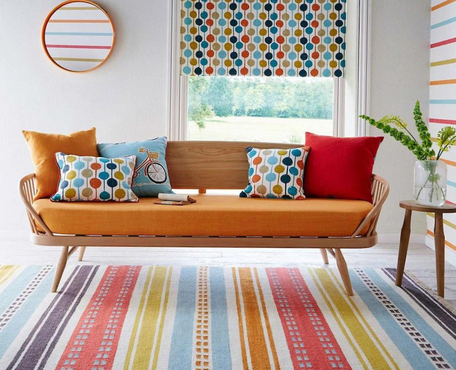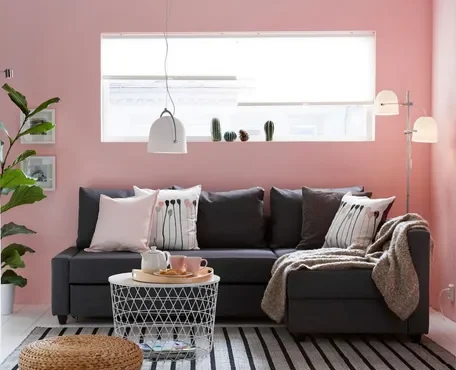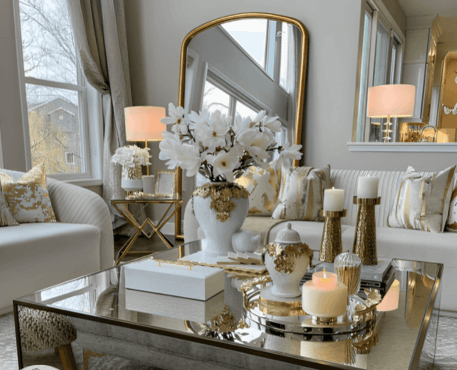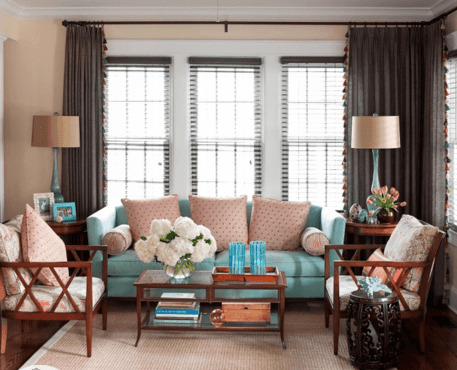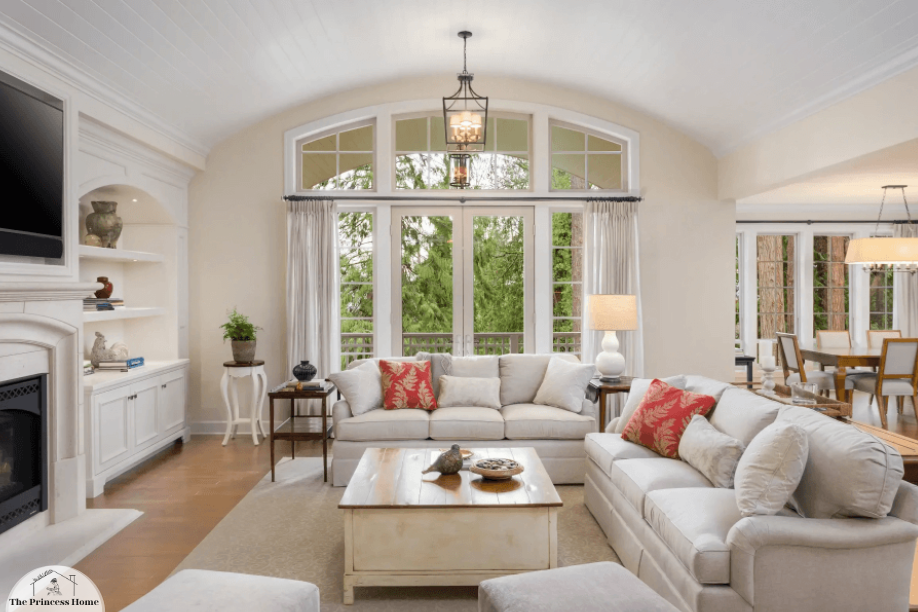
Simple living room ideas ; The living room is the heart of your home, a space where comfort and style converge to create an inviting atmosphere for both family and guests. While it may seem overwhelming to tackle the task of decorating, transforming your living room with simple and effective touches can breathe new life into the space. By combining creativity, practicality, and a keen eye for aesthetics, you can achieve a beautifully decorated living room that reflects your personality and offers a cozy haven for relaxation and socializing.
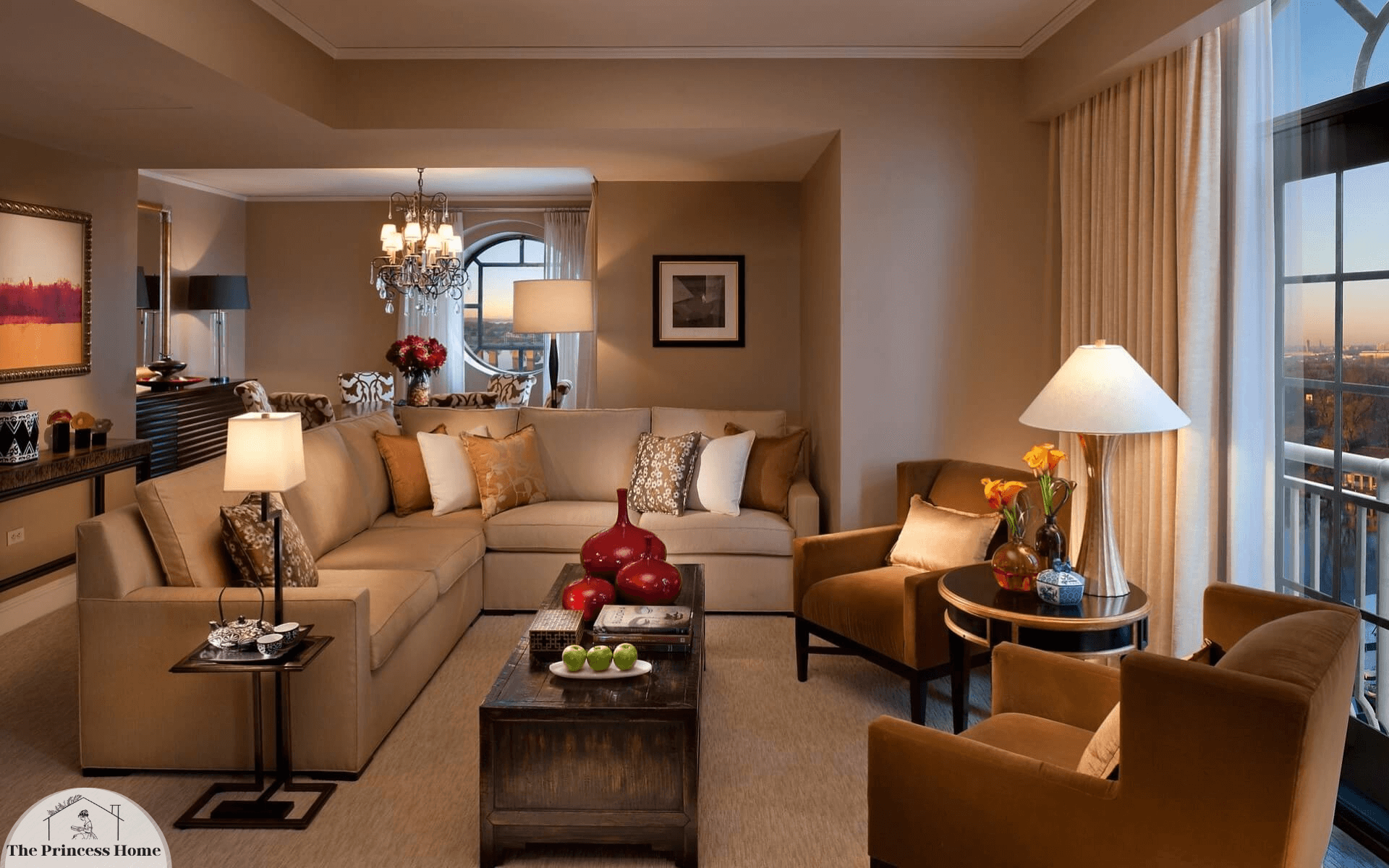
1. Define Your Style
Before embarking on your decoration journey, take some time to define your personal style. Whether you lean towards minimalist, rustic, contemporary, or eclectic aesthetics, understanding your preferences will guide your choices throughout the process. Consider colors, patterns, textures, and themes that resonate with you.
Certainly! Let’s explore how you can transform your living room using simple ideas and effective touches, considering different design styles. Remember to align these suggestions with your personal style, whether it’s minimalist, rustic, contemporary, or eclectic.
Minimalist Living Room Transformation:
Neutral Palette:
- Stick to a neutral color palette, such as whites, grays, and muted tones.
- Use a single accent color sparingly to add a touch of interest.
Clean Lines and Simple Furniture:
- Opt for sleek, minimalist furniture with clean lines and a simple design.
- Keep the furniture arrangement open and uncluttered.
Functional Décor:
- Choose décor items that serve a purpose, such as multifunctional furniture.
- Consider wall-mounted shelves for a practical yet decorative element.
Limited Accessories:
- Keep accessories to a minimum. Choose a few statement pieces rather than many small ones.
- Focus on quality over quantity for a more impactful look.
Rustic Living Room Transformation:
Natural Materials:
- Incorporate natural materials like wood, stone, and leather.
- Choose furniture with a distressed or reclaimed look.
Earthy Color Palette:
- Use warm earthy tones such as browns, greens, and deep reds.
- Include pops of color with rustic-inspired accessories.
Cozy Textures:
- Introduce cozy textures with throw blankets, faux fur, and woven rugs.
- Consider a statement rug with a traditional pattern.
Vintage Accents:
- Add vintage or handmade items like wooden crates, lanterns, or antique-inspired décor.
Contemporary Living Room Transformation:
Bold Colors:
- Experiment with bold and contrasting colors like black, white, and vibrant accents.
- Use a monochromatic palette with a pop of a bright color.
Sleek Furniture:
- Opt for sleek and modern furniture with clean lines.
- Consider furniture with metallic or glass accents.
Artistic Statements:
- Showcase contemporary art or sculptures as focal points.
- Use abstract patterns in rugs or throw pillows.
Technology Integration:
- Incorporate modern technology seamlessly, such as a sleek entertainment center or smart home devices.
Eclectic Living Room Transformation:
Mix of Styles:
- Combine furniture and décor from various styles for a diverse look.
- Don’t be afraid to mix patterns, textures, and colors.
Personalized Gallery Wall:
- Create a gallery wall with a mix of art, photographs, and eclectic wall décor.
- Include items collected from travels or sentimental pieces.
Mismatched Furniture:
- Use furniture that doesn’t necessarily match but complements each other.
- Play with different materials and shapes.
Bold Patterns and Textures:
- Introduce bold patterns and textures through rugs, throw pillows, and upholstery.
Remember, the key to a successful transformation is to blend these ideas according to your personal style preferences. Whether you lean towards one style or enjoy a mix, make sure the final result reflects your taste and creates a comfortable and visually appealing living space.
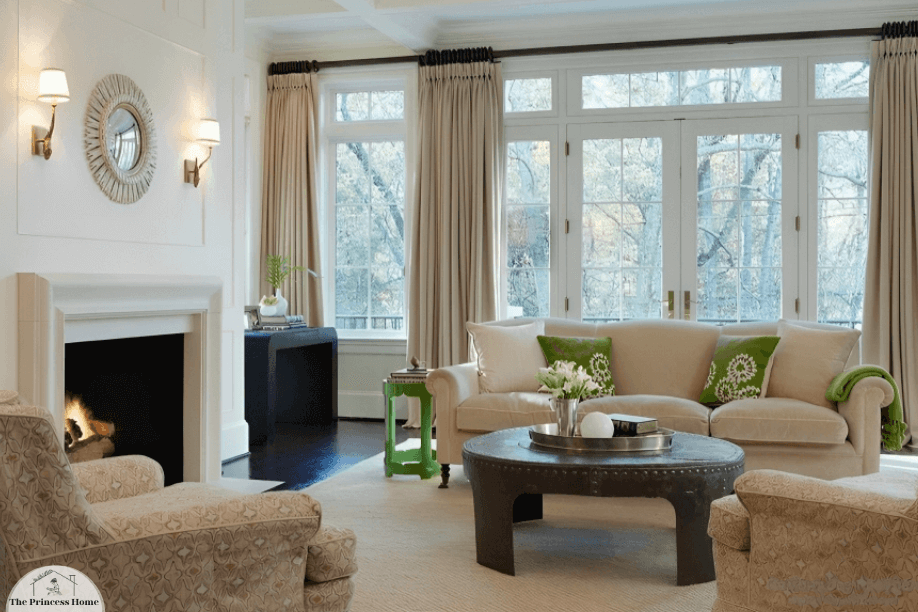
2. Choose a Cohesive Color Palette
Selecting a cohesive color palette is fundamental to creating a harmonious and visually pleasing living room. Opt for a primary color as the base and a couple of complementary accent colors. Neutrals like whites, grays, and beige can provide a versatile backdrop, while accent colors can be introduced through textiles, artwork, and accessories.
Certainly! Let’s explore a cohesive color palette that you can use as a foundation for your living room. We’ll start with a primary color and then incorporate a couple of complementary accent colors, along with neutrals for versatility.
Cohesive Color Palette:
Primary Color:
- Soft Blue/Grey: This calming and versatile color can serve as the main base for your living room. It creates a serene atmosphere and pairs well with various styles.
Accent Colors:
1.Muted Mustard:
- Use this warm and muted yellow as an accent color in throw pillows, artwork, or small décor items.
- Adds a touch of vibrancy without being overpowering.
2.Earthy Green:
- Introduce earthy green tones in plants, vases, or accent chairs.
- Enhances the natural feel and adds a sense of freshness.
3.Neutrals:
- White:
- Incorporate white for larger furniture pieces, walls, or as a base for décor items.
- Creates a clean and timeless backdrop.
- Warm Grey:
- Use warm grey for accent furniture, such as a sofa or side chairs.
- Adds depth and sophistication.
Tips for Implementation:
Balance the Colors:
- Distribute the colors evenly throughout the room to maintain balance.
- Ensure that one color doesn’t dominate the space.
Textures and Patterns:
- Introduce textures and subtle patterns in upholstery, rugs, or curtains to add visual interest.
- This enhances the depth of the color palette.
Natural Elements:
- Consider incorporating natural materials like wood or stone to complement the chosen color scheme.
- Plants also contribute to the overall harmony.
Flexibility:
- Keep larger furniture pieces and permanent fixtures in neutral tones for flexibility in future updates.
- Use accent colors in smaller, interchangeable items for a seasonal change.
Remember, the key to a cohesive color palette is to ensure that the colors work harmoniously together and reflect the overall ambiance you want to achieve in your living room. Experiment with different shades and test the palette in small doses before making final decisions.
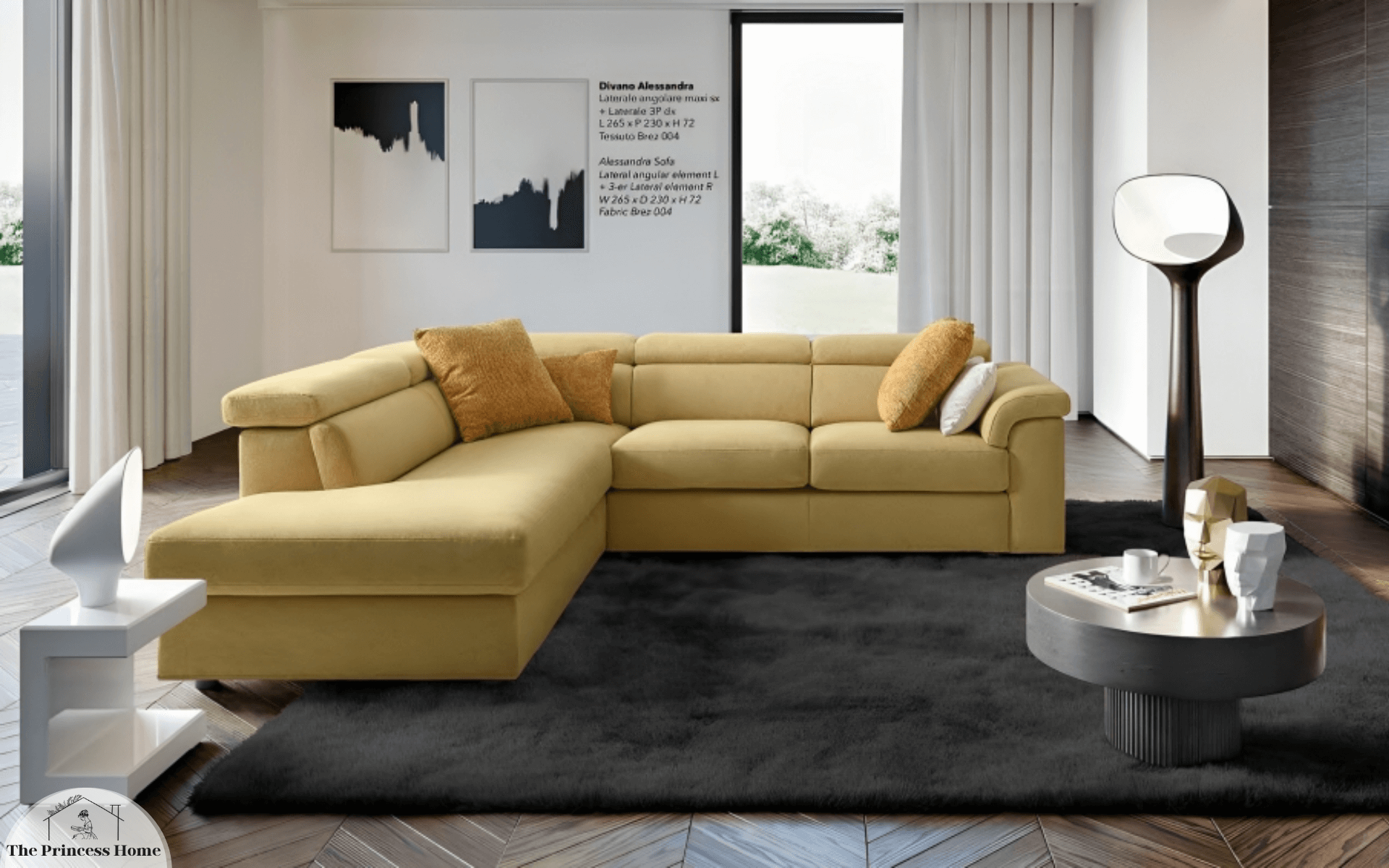
3. Arrange Furniture Strategically
Furniture arrangement plays a pivotal role in the functionality and flow of your living room. Consider the room’s layout and traffic patterns when placing sofas, chairs, and tables. A common strategy is to arrange seating to encourage conversation, often in a U-shape or L-shape configuration.
Absolutely! Furniture arrangement is crucial for creating a functional and aesthetically pleasing living room.
Here are some strategic tips for arranging your furniture to enhance the flow and encourage conversation:
1**Seating Arrangement:
1.Conversation Zones:
- Arrange seating to create distinct conversation zones. This is especially important if your living room is large.
- Place sofas and chairs facing each other to facilitate easy communication.
2.U-Shape or L-Shape Configuration:
- Consider arranging seating in a U-shape or L-shape to promote a sense of intimacy and inclusiveness.
- This layout is effective for both large and small living rooms.
3.Anchor the Space:
- Use a large area rug to anchor the seating arrangement.
- Ensure that the front legs of the furniture sit on the rug, creating a cohesive and well-defined space.
2**Traffic Flow:
1.Pathways:
- Allow for clear pathways through the room, ensuring easy navigation.
- Avoid placing furniture in a way that obstructs natural traffic flow.
2.Create Focal Points:
- Identify a focal point in the room, such as a fireplace, TV, or a large window.
- Arrange furniture to complement and highlight the focal point.
3**Furniture Placement:
1.Sofa Placement:
- Place the sofa against a wall to create a solid anchor for the seating area.
- If space allows, consider floating the sofa in the room for a more open feel.
2.Coffee Table:
- Ensure the coffee table is within easy reach of all seating.
- Choose a size that complements the seating arrangement without overwhelming the space.
3.Accent Chairs:
- Use accent chairs to fill corners and add extra seating without overcrowding the central area.
- Place them strategically to balance the layout.
4.Consider Functionality:
- Think about the purpose of the room. If it’s a multifunctional space, create zones for different activities, such as reading, watching TV, or playing games.
Additional Tips:
1.Experiment with Arrangements:
- Don’t be afraid to experiment with different furniture arrangements until you find the one that best suits your space and lifestyle.
2.Scale and Proportion:
- Pay attention to the scale of furniture in relation to the size of the room.
- Avoid overcrowding with oversized furniture in a small space.
3.Lighting Considerations:
- Ensure that lighting is evenly distributed throughout the seating areas.
- Use floor lamps, table lamps, or pendant lights strategically.
By carefully considering the layout, traffic flow, and focal points, you can create a living room that is not only visually appealing but also conducive to socializing and relaxation. Adjustments may be necessary based on the specific dimensions and features of your living room, so feel free to adapt these suggestions to best suit your needs.
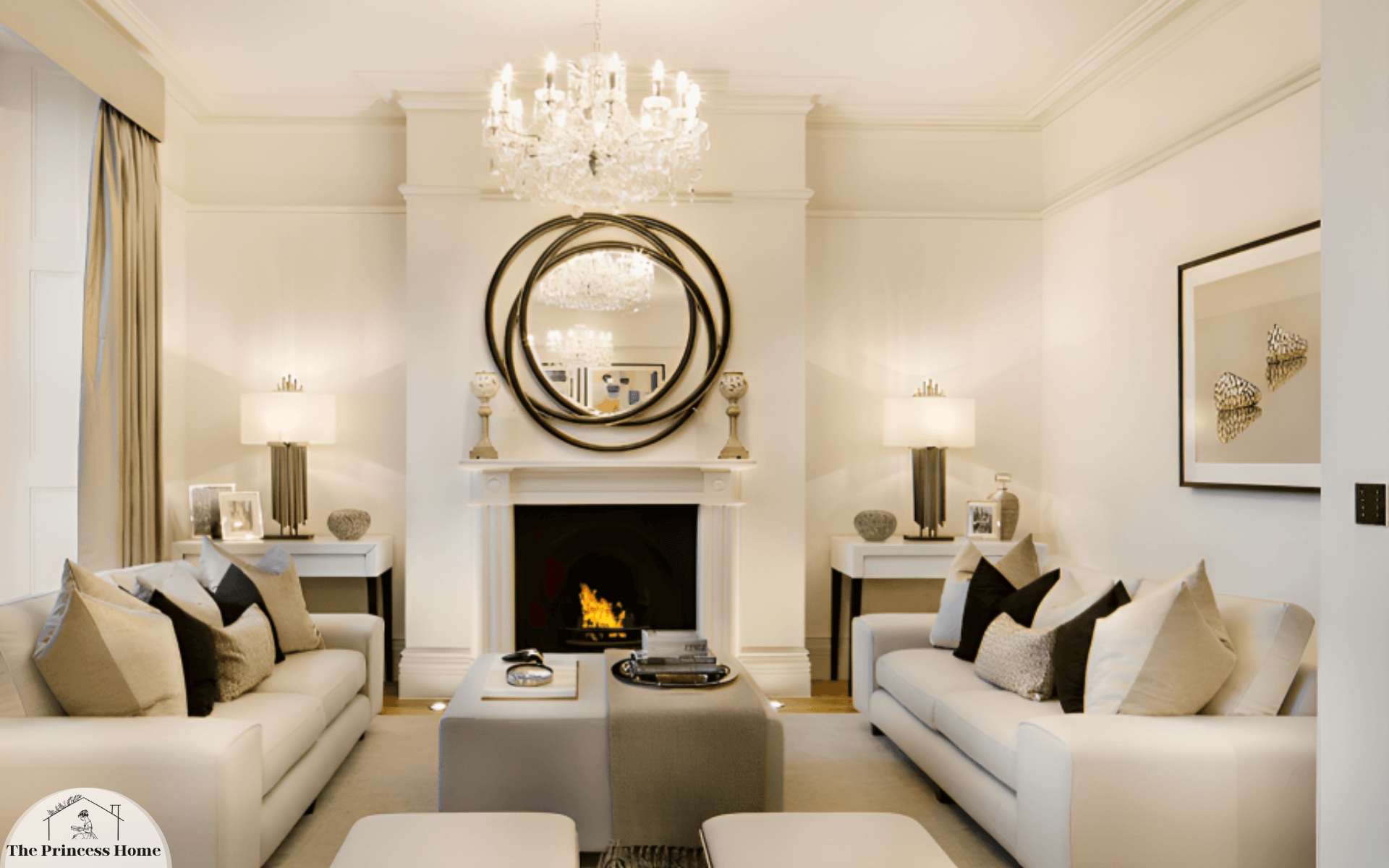
4. Incorporate Statement Pieces
Add character and focal points to your living room with statement pieces. These could be an eye-catching piece of artwork, an elegant mirror, an antique cabinet, or a uniquely designed coffee table. These items draw attention and become conversation starters.
Absolutely! Incorporating statement pieces is a fantastic way to infuse personality, style, and focal points into your living room.
Here are some ideas for statement pieces that can add character and become conversation starters:
1. Eye-Catching Artwork:
- Large Wall Art: Choose a sizable, bold piece of artwork that complements your color palette and style.
- Gallery Wall: Create a gallery wall with a mix of artwork, photographs, and other decorative elements.
2. Unique Furniture Items:
- Statement Sofa: Opt for a sofa with a distinctive design, color, or texture.
- Antique Cabinet or Sideboard: An antique or vintage piece can add character and serve as a focal point.
3. Mirrors:
- Oversized Mirror: A large, decorative mirror can create a sense of space and reflect light, making the room feel brighter.
- Ornate Mirror: Choose a mirror with an interesting frame to add a touch of elegance.
4. Bold Lighting Fixtures:
- Chandelier or Pendant Lights: Install a striking chandelier or pendant lights to draw attention upward.
- Floor Lamps: Choose a floor lamp with a unique design or a sculptural base.
5. Sculptural or Unique Coffee Table:
- Artistic Coffee Table: Select a coffee table with a distinctive shape, material, or design.
- DIY Project: Consider repurposing or customizing a coffee table for a one-of-a-kind look.
6. Accent Chairs:
- Colorful or Patterned Chairs: Introduce statement chairs with vibrant colors or bold patterns.
- Sculptural Chairs: Choose chairs with unique shapes or designs.
7. Textured or Patterned Rug:
- Bold Rug: Lay down a rug with a bold pattern or vibrant colors to anchor the seating area.
- Textured Rug: Choose a rug with an interesting texture, like a shag or a woven design.
8. Personalized Decor Items:
- Travel Souvenirs: Display unique items collected from your travels.
- Custom Art or Decor: Commission or create custom pieces that reflect your personal style.
9. Statement Plants:
- Large Indoor Plants: Incorporate oversized or uniquely shaped indoor plants.
- Artistic Planters: Use creative planters to add an extra layer of visual interest.
10. Wall Murals or Wallpaper:
- Bold Wallpaper: Consider an accent wall with bold, patterned wallpaper.
- Mural or Wall Decals: Choose a mural or decals that make a statement without overwhelming the space.
Remember to balance statement pieces with the overall style of the room and avoid overcrowding. These items should complement the existing decor while adding that extra touch of uniqueness and individuality to your living space.
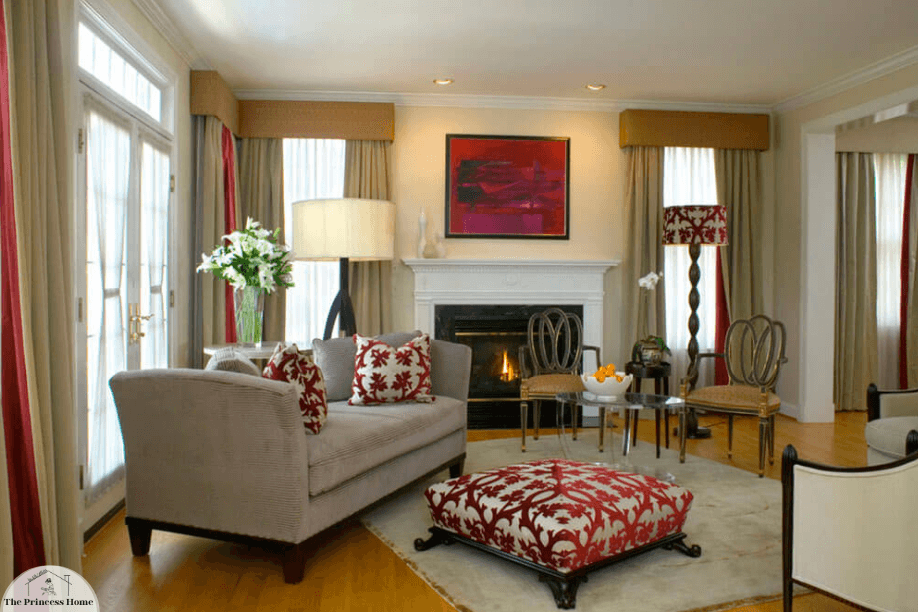
5. Harness the Power of Textiles
Textiles, such as throw pillows, blankets, curtains, and rugs, are essential for layering textures and adding warmth to your living room. Mix and match patterns and materials while staying within your chosen color palette to achieve a balanced and inviting look.
Here’s how you can harness the power of textiles to create a layered and inviting space:
1. Throw Pillows:
- Mix Patterns and Sizes: Combine throw pillows with different patterns, textures, and sizes.
- Color Coordination: Choose pillows that complement your color palette while adding visual interest.
2. Blankets and Throws:
- Layered Throws: Drape blankets or throws over sofas and chairs to add layers of texture.
- Textured Materials: Opt for blankets with interesting textures like knits, faux fur, or woven fabrics.
3. Curtains:
- Long and Flowing: Choose curtains that are long and touch the floor for an elegant and cozy feel.
- Patterned or Textured Curtains: Introduce patterns or textures that enhance the overall aesthetic.
4. Rugs:
- Area Rugs: Define seating areas with area rugs that complement your color palette.
- Mix Materials: Experiment with different rug materials, such as wool, jute, or shag, to add variety.
5. Upholstery:
- Textured Upholstery: Consider sofas or chairs with textured upholstery, like velvet or linen.
- Patterned Accent Furniture: Introduce patterned accent furniture to create focal points.
6. Mixing Materials:
- Combine Natural and Synthetic Fabrics: Balance natural materials like cotton or wool with synthetic materials like polyester or acrylic.
- Leather Accents: Incorporate leather elements for a touch of sophistication and durability.
7. Color Palette Consistency:
- Stay within the Palette: Ensure that all textiles adhere to your chosen color palette.
- Neutral Base: Use neutral tones as a base and introduce pops of color through textiles.
8. Seasonal Changes:
- Switch Out Seasonally: Rotate textiles seasonally to keep the space fresh and adapt to changing weather.
- Lighter Fabrics for Summer: Use lighter fabrics like linen during warmer months and warmer, heavier fabrics for the colder seasons.
9. DIY Textile Projects:
- Customize Existing Textiles: Add personal touches to existing textiles through DIY projects like tie-dye, embroidery, or fabric painting.
- Mix Old and New: Blend vintage or handmade textiles with newer pieces for a unique look.
10. Texture Harmony:
- Coordinate Textures: Ensure that various textiles in the room harmonize in terms of texture.
- Contrast Textures: Introduce some contrast in texture to prevent monotony.
By thoughtfully incorporating textiles, you can enhance the visual appeal and comfort of your living room. Experiment with different combinations, keeping in mind the balance of patterns, materials, and colors to achieve a cohesive and inviting atmosphere.
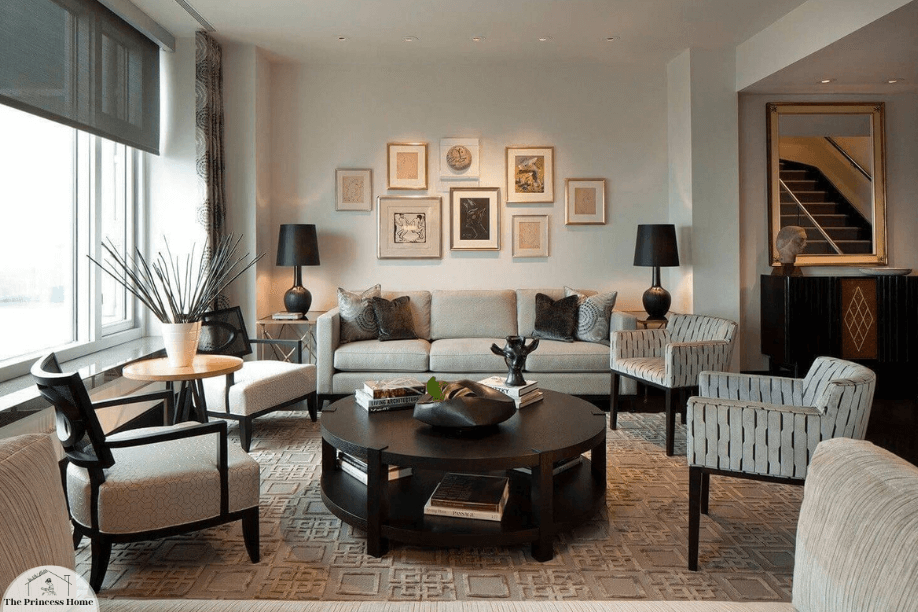
6. Personalize with Decorative Accessories
Incorporate your personality and experiences into the room by displaying decorative accessories. Family photos, travel souvenirs, and treasured mementos can be tastefully arranged on shelves, mantels, or walls, injecting a sense of nostalgia and warmth.
Absolutely! Personalizing your living room with decorative accessories is a wonderful way to make the space truly your own.
Here are some ideas on how to incorporate your personality and experiences into the room:
1. Family Photos:
- Gallery Wall: Create a gallery wall with framed family photos.
- Photo Displays: Use photo ledges or a picture rail for a flexible and interchangeable display.
2. Travel Souvenirs:
- Display Collections: Showcase souvenirs from your travels on shelves or in curated displays.
- Shadow Boxes: Create shadow boxes with small items like tickets, postcards, or small artifacts.
3. Treasured Mementos:
- Showcase Special Items: Dedicate a space to display meaningful objects or heirlooms.
- Memory Jars or Bowls: Use decorative containers to hold small mementos like ticket stubs, notes, or shells.
4. Art and Wall Decor:
- Personal Artwork: Display your own artwork or creations if you enjoy crafting.
- Statement Art Pieces: Choose art that resonates with you and reflects your interests or values.
5. Books and Magazines:
- Styled Bookshelves: Arrange books and magazines in an aesthetically pleasing way on bookshelves.
- Coffee Table Books: Use coffee table books that align with your interests as decorative elements.
6. Personal Collections:
- Curate Collections: Showcase collections of items like vintage cameras, figurines, or antique books.
- Themed Displays: Arrange items with a common theme to create visual impact.
7. Textile and Fabric Keepsakes:
- Quilts or Blankets: Display handmade quilts or blankets passed down through generations.
- Embroidered or Personalized Pillows: Use throw pillows with personal touches like monograms or embroidery.
8. Candles and Candle Holders:
- Decorative Candle Arrangements: Arrange candles in decorative holders or trays.
- Scented Candles: Choose scents that evoke positive memories or relaxation.
9. Plants and Greenery:
- Personalized Planters: Use planters that have sentimental value or unique designs.
- Indoor Garden: Create a small indoor garden with plants that hold personal significance.
10. Customized Items:
- Monogrammed Decor: Add monogrammed or personalized items like cushions or wall art.
- Customized Signs or Quotes: Display favorite quotes or personalized signs.
11. Functional Decor:
- Unique Clocks: Choose a clock with a unique design or a personal touch.
- Functional Decorative Items: Incorporate functional items like vintage typewriters, globes, or telescopes.
12. Rotating Displays:
- Seasonal Rotation: Change out displays seasonally to keep the room feeling fresh.
- Rotate Personal Art: Swap out personal artwork or photographs to keep the space dynamic.
By incorporating these personalized touches, you’ll create a living room that not only looks aesthetically pleasing but also tells a story about you and your experiences. It adds layers of depth and warmth, making the space feel truly unique and inviting.
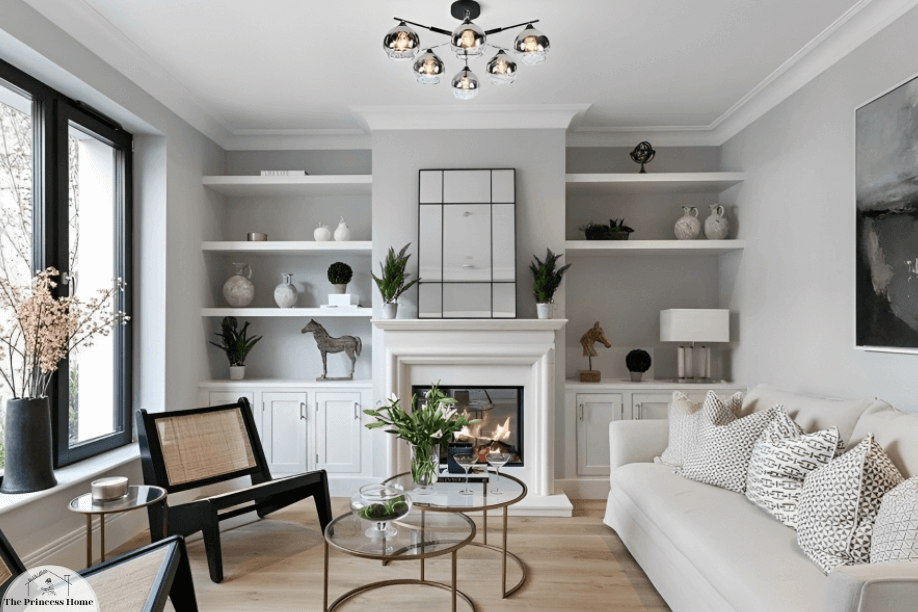
7. Greenery and Natural Elements
Introducing plants and natural elements into your living room can instantly infuse a fresh and vibrant vibe. Houseplants not only purify the air but also add a touch of nature’s beauty. Consider placing potted plants on windowsills, shelves, or using larger floor plants as decorative statements.
Absolutely! Bringing greenery and natural elements into your living room is a fantastic way to enhance the space with freshness and a connection to nature.
Here are some ideas on how to incorporate plants and natural elements into your living room:
1. Potted Plants:
- Windowsill Gardens: Arrange small potted plants on windowsills to catch natural light.
- Tabletop Plants: Place smaller plants on coffee tables or side tables for a subtle touch of greenery.
2. Shelving Displays:
- Floating Shelves: Use floating shelves to create a display of various-sized potted plants.
- Hanging Planters: Incorporate hanging planters to add visual interest at different heights.
3. Large Floor Plants:
- Statement Floor Plants: Consider larger floor plants in decorative pots as focal points.
- Corner Greenery: Place tall plants in corners to add height and drama.
4. Terrariums and Succulents:
- Succulent Arrangements: Create succulent arrangements in stylish containers.
- Terrariums: Display small terrariums with a variety of plants for a modern touch.
5. Natural Materials:
- Woven Baskets: Use woven baskets as decorative plant containers for a bohemian feel.
- Wooden Plant Stands: Elevate plants with wooden stands to add a natural and elegant touch.
6. Indoor Trees:
- Fiddle Leaf Fig or Rubber Plant: Consider larger indoor trees for a dramatic effect.
- Tree in a Basket: Place a potted tree in a decorative basket for a stylish look.
7. Botanical Prints and Artwork:
- Botanical Art: Hang framed botanical prints or artwork featuring plant motifs.
- Nature-Inspired Murals: Consider a wall mural that brings the outdoors inside.
8. Green Decor Accents:
- Green Cushions and Throws: Introduce green textiles like cushions or throws to complement the plant theme.
- Green Vases or Planters: Display plants in green-colored or earthy-toned planters.
9. Herb Garden:
- Kitchen Herb Garden: If your living room is connected to the kitchen, consider a small herb garden on the windowsill.
- Hanging Herb Planters: Use hanging planters to grow herbs vertically.
10. Seasonal Flowers:
- Fresh Cut Flowers: Bring in seasonal flowers in vases for a burst of color and fragrance.
- Dried Flowers: Consider dried flowers for a rustic and timeless appeal.
11. Natural Light:
- Maximize Natural Light: Ensure that your plants receive adequate natural light for optimal growth.
- Adjust Placement: Move plants around to follow the sunlight throughout the day.
12. Plant Care Essentials:
- Watering Schedule: Establish a consistent watering schedule based on the needs of your plants.
- Pruning and Maintenance: Regularly prune and maintain your plants to keep them healthy and thriving.
By incorporating greenery and natural elements, you not only enhance the visual appeal of your living room but also create a healthier and more vibrant indoor environment. Plus, the presence of plants can have a positive impact on mood and well-being.
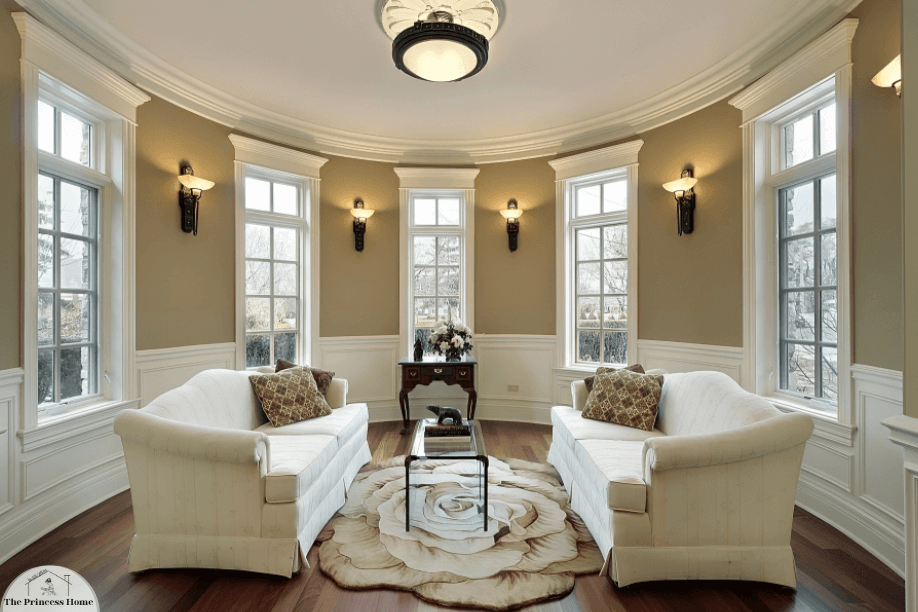
8. Proper Lighting
Lighting can dramatically influence the mood and ambiance of a room. Layer lighting sources, including ambient, task, and accent lighting, to create a well-lit and inviting space. Floor lamps, table lamps, and even string lights can add both functionality and charm.
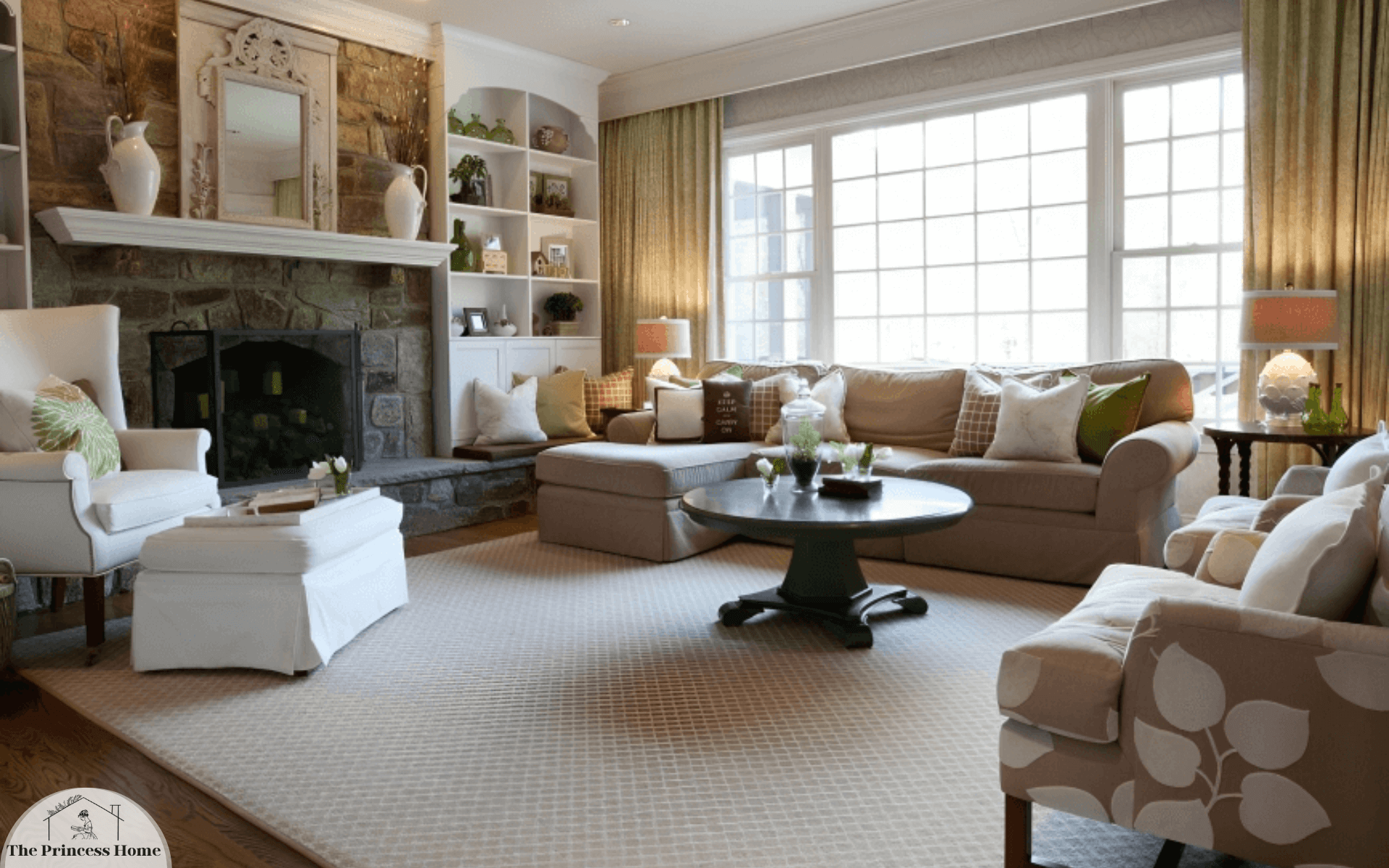
9. Incorporate Functional Storage
A clutter-free living room is a peaceful one. Integrate functional storage solutions that also contribute to the room’s aesthetics. Floating shelves, stylish storage ottomans, and media consoles can help keep the space organized while adding visual interest.
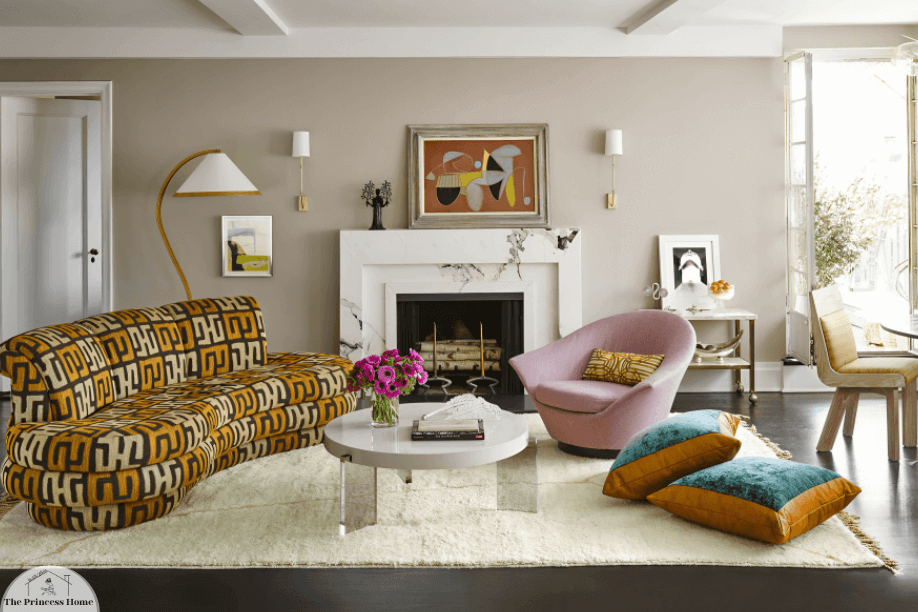
10. Embrace the Art of Minimalism
Less can often be more when it comes to decorating. Embracing minimalist principles can create a serene and sophisticated living room. Focus on a few key pieces, eliminate unnecessary clutter, and allow each element to shine.
Conclusion:
Decorating your living room with simple yet impactful touches can transform it into a space that resonates with your style, provides comfort, and fosters connection. By following these guidelines and infusing your personal creativity, you can create a living room that is a true reflection of your taste and a welcoming haven for both relaxation and social interaction. Remember that the journey of decorating is just as enjoyable as the destination, so take your time, experiment, and let your living room evolve into a space you cherish.
Q1: How do I choose the right color palette for my living room?
A1: Selecting the right color palette for your living room depends on your personal preferences and the mood you want to create. Begin by identifying a primary color that resonates with you. Then, choose complementary accent colors that harmonize well with the primary color. Consider the existing colors in your furniture and decor to ensure a cohesive look. Neutrals like whites, grays, and beige can serve as a versatile backdrop, while accent colors can be introduced through textiles, artwork, and accessories.
Q2: What’s the best way to arrange furniture for optimal flow and functionality?
A2: Arranging furniture strategically is crucial for creating an inviting and functional living room. Take into account the room’s layout and traffic patterns. Arrange seating in a way that encourages conversation, often in a U-shape or L-shape configuration. Leave enough space for easy movement around the furniture and ensure that key pieces, such as the coffee table, are within reach of each seating area. Experiment with different arrangements to find the one that suits your space and needs best.
Q3: How can I incorporate plants into my living room decor?
A3: Adding plants to your living room can bring a refreshing and natural element to the space. Choose plants that thrive indoors and are suited to the lighting conditions of your room. Place potted plants on windowsills, shelves, or side tables. Larger floor plants can serve as decorative statements in corners or near seating areas. The greenery not only adds aesthetic appeal but also contributes to improved air quality.
Q4: What are some effective ways to create a minimalist living room design?
A4: Creating a minimalist living room involves focusing on essential elements and eliminating clutter. Start by selecting a neutral color palette that promotes a sense of calm. Choose a few key furniture pieces with clean lines and simple designs. Keep decor and accessories to a minimum, opting for a few statement pieces rather than overcrowding the space. Embrace functional storage solutions to keep items out of sight and maintain a clutter-free environment. The goal is to create a serene and uncluttered atmosphere that promotes relaxation.
Q5: How can I incorporate proper lighting into my living room decor?
A5: Proper lighting is essential for setting the mood and enhancing the ambiance of your living room. Layer different types of lighting sources for a well-balanced effect. Start with ambient lighting, such as overhead fixtures or ceiling lights. Add task lighting, like table lamps or reading lights, to provide focused illumination for specific activities. Finally, incorporate accent lighting through wall sconces, floor lamps, or even string lights to create visual interest and a cozy atmosphere.
Q6: What are some tips for displaying decorative accessories without creating a cluttered look?
A6: Displaying decorative accessories in an organized and tasteful manner is key to avoiding a cluttered appearance. Choose a few meaningful pieces that reflect your personality and style. Group similar items together, like a collection of vases or framed photos, to create a cohesive look. Consider using shelves, mantels, and wall space to arrange these items in an aesthetically pleasing manner. Remember the principle of “less is more” – a few well-chosen accessories can make a more significant impact than an abundance of small items.
Q7: How can I balance aesthetics and functionality when decorating my living room?
A7: Balancing aesthetics and functionality involves making deliberate choices that enhance both the visual appeal and practicality of the space. Invest in furniture that not only looks good but also serves its intended purpose comfortably. Choose storage solutions that blend seamlessly with the decor while keeping clutter at bay. Opt for textiles that are not only visually appealing but also offer comfort and coziness. By carefully selecting items that marry form and function, you can achieve a harmonious living room that caters to both style and practicality.


